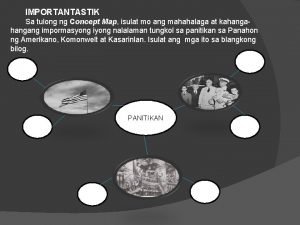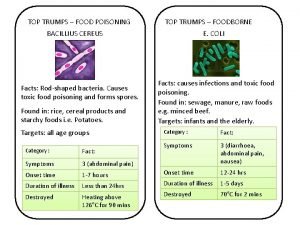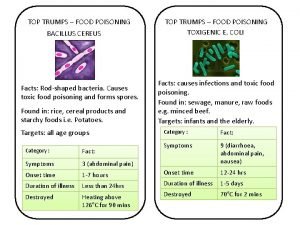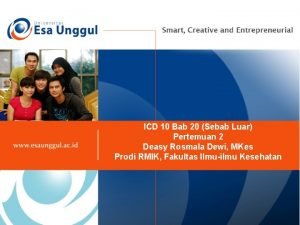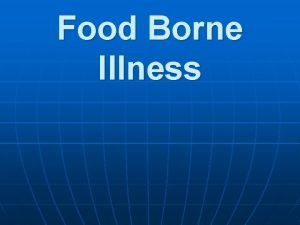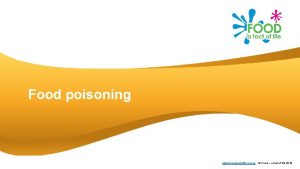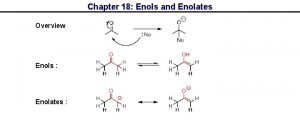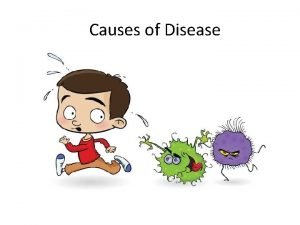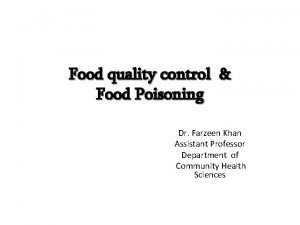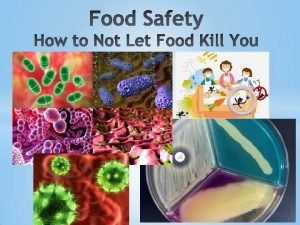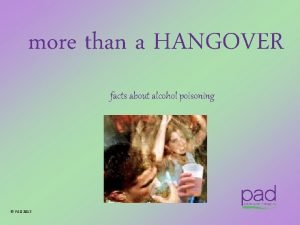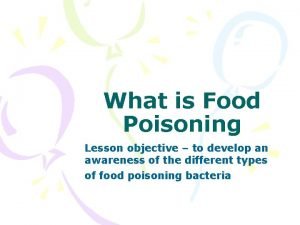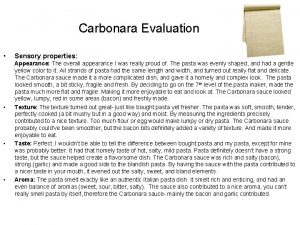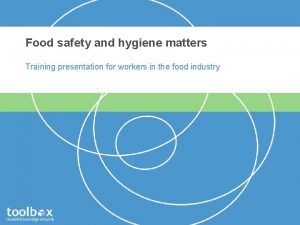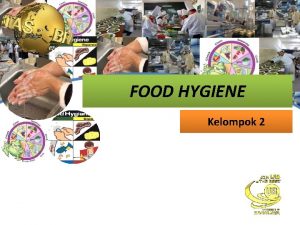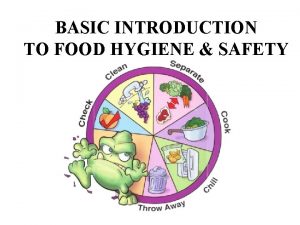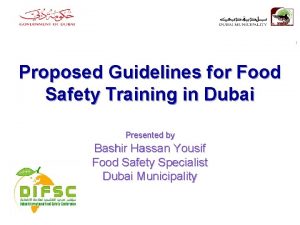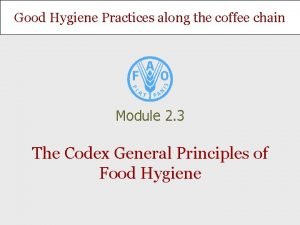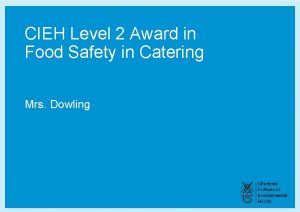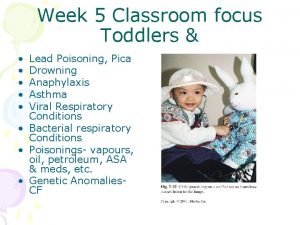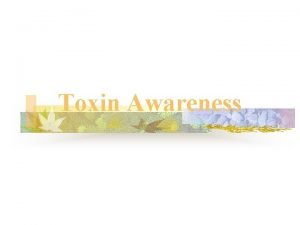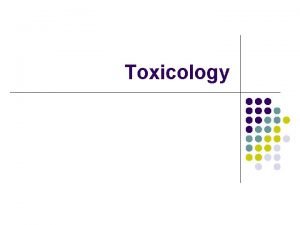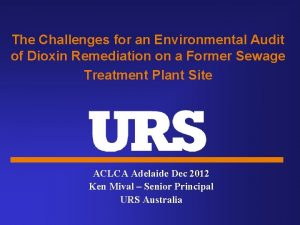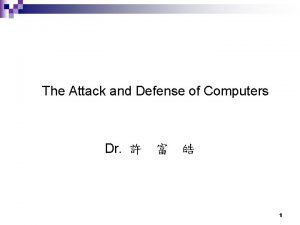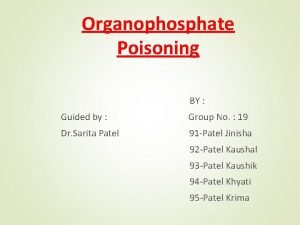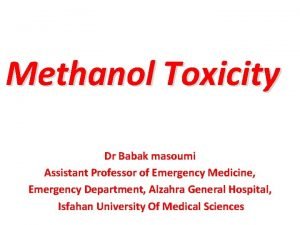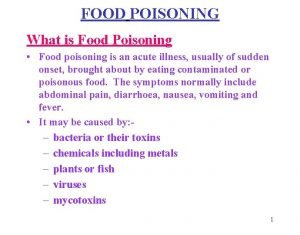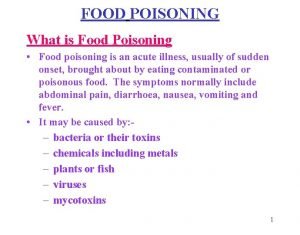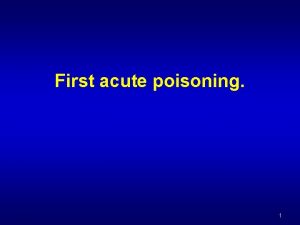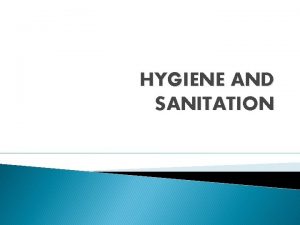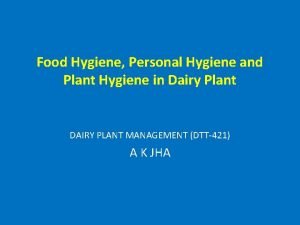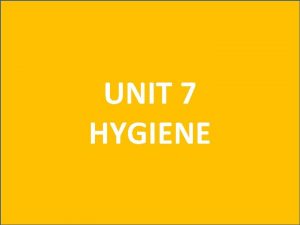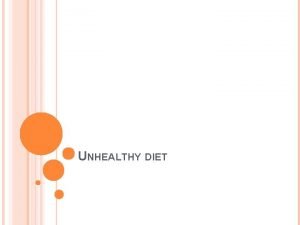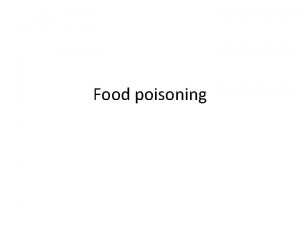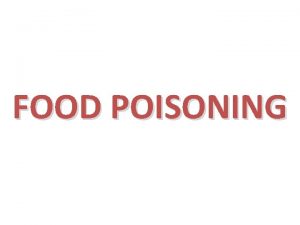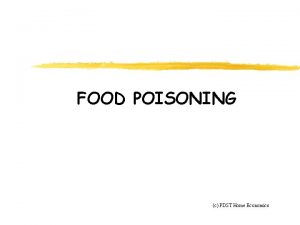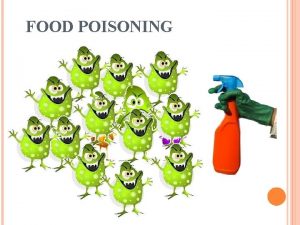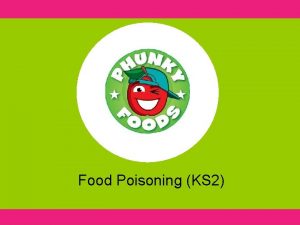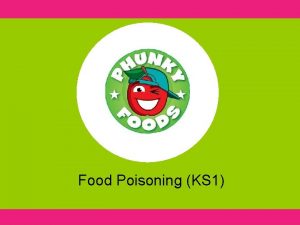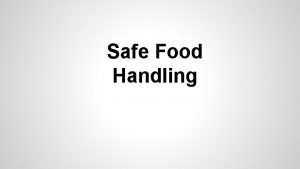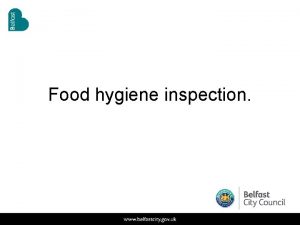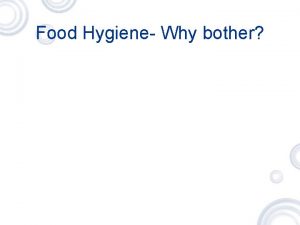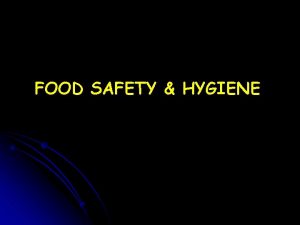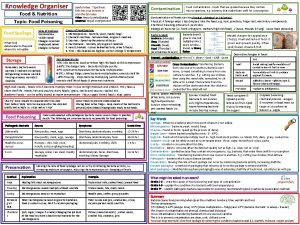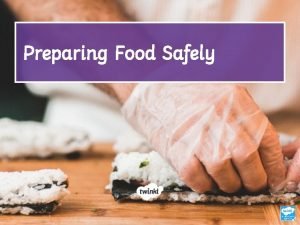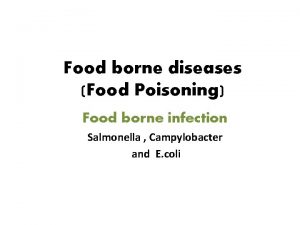HYGIENE OF NUTRITION FOOD POISONINGS CONSEPT FOOD POISONING



























- Slides: 27

HYGIENE OF NUTRITION FOOD POISONINGS

CONSEPT “FOOD POISONING” l Food poisoning – it is usually acute and mass diseases, connected with using food products, not – contagious nature (not infection diseases).

CLASSIFICATION ALIMENTARY POISONINGS 1. ALIMENTARY POISONINGS OF MICROBIAL ETIOLOGY 2. ALIMENTARY POISONINGS OF NOT MICROBIAL ETIOLOGY: 3. MYCOTOXICOSIS 4. ALIMENTARY POISONINGS OF NOT INVESTIGATED ETIOLOGY

ALIMENTARY POISONINGS OF MICROBIAL ETIOLOGY: 1. TOXICOINFECTIONS - at penetrating of alive microbes in organism with food (Salmonella, E. coli, Proteus, Cl. perfringens, Bac. cereus etc. ) 2. BACTERIAL TOXICOSES - at penetrating of microbial toxins in organism with food: а) Staphylococcal toxicosis (Toxin of Staphylococcus aureus) b) BOTULISM (Toxin of Clostridium botulinum)

TOXICOINFECTIONS Product sources: meat products, especially minced, eggs, fish, milk products. Conditions when products become dangerous: 1) The reasons of hit of activators in products: а) using meat from ill animals, b) Wrong storage and transportation products, c) Non-observance by the personnel of food objects rules personal hygiene, work at kitchen ill people. 2) The reasons of duplication and preservation activators in products: а) Wrong storage - non-observance temperature and terms of realization, 3) Insufficient thermal processing food products for killing big amount of microbes

Clinical forms toxicoinfection There are 5 clinical forms: 1) Gastro-enteritis form: nausea, vomiting, diarrhea, pains in stomach а) easy degree - in 80 %, b) average degree – in 20 % (rise temperature up to 38), c) the heavy form - in 2 % - body temperature 38 -40 С, decrease of arterial pressure, very heavy intoxication. 2) Typhoid form – heavy intoxication with intermitted temperature 3) Choleric form – heavy intoxication with strong diarrhea 4) Dysentery form – diarrhea with blood in fecal masses 5) Grippe form – like grippe with gastro-enteritis.

BACTERIAL TOXICOSIS Staphylococcal toxicosis. Products - sources: creams, pies, cakes, milk products. Conditions of hit staphylococcus and collect it toxin in products: а) Staphylococcal diseases of the personnel of eating establishments - quinsy, pustular diseases of a skin of hands, b) Wrong storage - at room temperature, non-observance terms of realization. Symptoms: gastro-enteritis at high temperature, diarrhea seldom, in heavy cases – infringement cardiac system, dehydrotation organism.

BOTULISM Features of the activator (botulin stick - Clostridium botulini): а) spore-making - spores maintain boiling 4 -5 hours, maintain action of preservatives - salts, vinegar, sugar long time, b) obligate anaerobe microbe - develops without access oxygen (canned food), в) Under certain conditions (+ 10 - +30 С without oxygen) is formed the strongest neurotropic exotoxine - a fatal doze for person 35 microgramm.

Symptoms of botulism Toxin amazes central nervous system - nucleus of skull-brain nerves. Nucleus of nerve oculomotorius – pthosis (falling of upper eyelid at one eye), anisocaria (different diameter of pupils of the eyes), frustration accommodation of eyes, - Nucleus of optic nerve - a fog, "net" before eyes, decrease of sight - Nucleus of glossopharyngeus and hypoglossal nerve - violations of speech up to aphonia (person can not speak), violations of swallowing (person can not drink water), - Nucleus of facialis nerve - disappearance tonus of mimic and chewing muscles at the one half of face, - Nucleus of vagus nerve - increase pulse at the normal or lowered temperature, defecation is normal or propensity to obstipation (as against other microbe food poisonings!). Then in patient may be spasms, pains in muscles, defeat of respiratory centers in central nervous system - death. - The mortality at not treatment botulism - up to 70 %, at treatment -up to 30%.

Treatment botulism Introducing of antybotulinic serum or anatoxine (doze 15000 IU, repeat in a doze 5000 IU in 5 hours) intravenous. At the use suspicious product prevention - introduction serum in a doze 2000 IU.

2. ALIMENTARY POISONINGS OF NOT MICROBIAL ETIOLOGY: 1) BY TOXICANT PRODUCTS: а) Toxicant mushrooms (pale poganka, fly-agaric etc. ) b) Toxicant plants (beladonna, etc. ) c) Toxicant weeds (heliotrope) d) Toxicant parts of some fishes 2) BY PRODUCTS SOMETIMES OR PARTICULATE TOXICANT: а) Stone fruits (amygdaline) b) String bean (fasin) c) Potato (solanine) 3) BY CHEMICAL MATERIALS: а) Heavy metals - lead, copper, zinc b) Pesticides c) Nitrates and nitrites d) Alimentary additives

Poisonings by heavy metals. The reasons: а) From utensils (the zinc buckets, copper utensils, glaze on pottery), b) From the ground polluted with heavy metals (about highways) Zinc and copper (cuprum). Not heavy gastroenteritis – in intestines are formed copper and zinc albuminates - are not soaked up in organism - ulcering, irritating action at intestines. Lead. I Symptoms - a lead triad: - lead encephalopathia and polyneuritis, - lead pains in stomack, - lead border on gums. In blood - bazophylic granularity of erythrocites, retyculocitosis, In urine increase contents of lead (more than 0, 04 mg / l).



Food poisonings by agrochemicals. Food poisonings by pesticides. Pesticides - chemical means for protection plants from wreckers, illnesses and weeds. Without application of it is loss 50 % of a crop. The reasons accumulation pesticides in products: а) Application the non-authorized preparations (very proof or toxic), b) Excess the established norms of the charge or frequency rate of processing, c) Non-observance term of expectation - time between last processing of plants and harvesting. The clinic poisonings depends on group of pesticides – chlorine- organic, phosphorus-organic, carbamates, etc. (Blocade enzymes – cytochromoxidaze, cholinesteraze).

Food poisonings by fertilizers. Fertilizers - substances for increase productivity plants. Nitric fertilizers are most of all applied. Thus in plants nitrates can collect - in organism are restored in nitrites and connect with haemoglobin – methaemoglobinaemia – absence transport of oxygen - hypoxia. Are especially dangerous to children of first 3 months. At high levels of nitrates at high temperature in products can form nitrozo-connections (NC) - cancerogenic effects on stomack.

Food poisonings by food additives. Now more than 5000 chemical substances are now use as food additives. Example – using nitrates as paintings in sausage - metgaemoglobinaemia CLASSIFICATION ALIMENTARY ADDITIVES, ALLOWED TO APPLICATION IN THE COUNTRIES OF EUROPEAN UNION Е 100 - Е 200 - stains Е 200 - Е 300 - preservatives Е 300 - Е 400 - antioxidants, regulators acidity Е 400 - Е 600 - emulgents, stabilizers consistence, materials handicapping conglomeration Е 600 - Е 900 - amplifiers taste, flavors Е 900 - Е 1000 - materials enriching quality of a grain and bread

MYCOTOXICOSIS Sort of fungi Mycotoxins Food products Pathology Aspergillus Aflotoxins nuts, coffee cirrhosis and primary cancer of a liver Aspergillus Ochratoxins grain, coffee Balkan epidemic nephropathy Fusarium Trychocetens grain 1. Fusariosis 2. Alimentarytoxic aleukia Claviceps alkaloids of ergot grain Ergotism Penicillium Pathulin juices, mashed potatoes Malignant tumours

Mycotoxicoses Ergotism. At hit in organism grain with ergot. Toxins – ergotoxine, ergotamine, ergometrine. Cause a spasm of smooth, then - another muscles. In clinic distinguish 3 forms: а) Convulsive, b) Gangrenous, c) Mixed Ergotism is especially dangerous for pregnant - a spasm of smooth muscles of uterus - abortions, premature birth. Fusarios. A poisoning by "drunk bread". In clinic - gasthroenteritis + defeat of CNS as alcogol intoxication.

Alimentary-toxic aleukia. Up to 1944 it was named - "septic quinsy". Deep infringements of blood-forming, leuko- and trombocytopenia. The main attribute - aleukia (in 1 -2 weeks) - sharp decrease leukocytes in blood – no protection from microbes. Heavy necrotic quinsy and a sepsis. Mortality - 50 -80 %. Аflotoxicoses. Can develop on a peanut and аraxis nuts, on grain, corn, coffee, cacao, rice, in Spain vine. Develop at storage in damp conditions at the increased temperature (Countries with hot climate). CLINIC Heavy defeat of a liver and cancerogenic effect on a liver - an initial cancer of a liver.

ALIMENTARY POISONINGS NOT INVESTIGATED ETIOLOGY 1) Alimentary paroxyzmal toxic mioglobin-uria (Gaffen illness) 2) Poisoning by meat of quail 3) Urov illness (Kashin – Beck’s illness) (poly-hyper-microelementosis on strontium, manganese and fluorine)

TACTICS OF THE DOCTOR IN CASE OF FOOD POISONING 1. Statement the preliminary diagnosis on the basis: а) Food anamnesis of the ill person or relatives, b) Clinic with characteristic symptoms 2. Rendering emergency medical service under vital indications - cardiacs, respiratory analeptics, etc. 3. Confirmation the diagnosis: sending in laboratory department of the hygiene of nutrition of SES the rests of food, washing waters of a stomach, emetic weights, fecal masses, blood, urine. To write the "Accompanying direction on laboratory research"

4. Desintoxication therapy: washing of a stomach, plentiful drink, antibiotics. At a botulism - antibotulinic whey, anatoxine. 5. Prevention other cases of food poisoning – doctor write "Emergency notice about food poisoning" - send to SES and inform SES by the phone. After reception the emergency notice doctors of SES within 24 hours will carry out sanitary inspection of a public catering establishment, honey, survey of the personnel. 6. In heavy cases - hospitalization in an infectious hospital by first aid.

FOOD POISONINGS NOT MICROBIC AETHYOLOGY 1. Poisonings by poisonous mushrooms. Contains different toxines: ammonitotoxine, ammonitohaemolysin, muscarin and mycoathropin. Clinic: gasthroenteritis, changes of nervous system, cardiac system. Prevention poisonings by poisonous mushrooms. 1) Population must know poisonous mushrooms. Sanitary - educational work: lectures, conversations, posters, use mass media (TV). 2) The control in the markets - sale mushrooms under the sanction of the sanitary medical assistant.

2. Poisonings by poisonous wild-growing plants. Are most typical at children's age. Plants contain M - cholynolytics - atropine, giosciamine, scopolamine. Representatives - beladonne, benbane, dope. CLINIC Gasthroenteritis + expansion of pupils (beladonne). At poisoning by other plants - hallucinations + oppression central nervous system (CNS). Prevention poisonings by poisonous plants. 1) Destruction in territory of children's preschool establishments 2) The control of children at walking in parks. Sanitary-educational work with tutors.

3. Poisonings by products sometimes or in part poisonous Solanin in a potato. In growing and become green potato. Has irritating and haemolytic action. Gasthroenteritis of easy and average degree of weight. Fazin in unripe haricot beans. Its toxin gives irritation and gaemagglutination action. Gasthroenteritis of easy and average degree of weight. Amygdalin in stone fruits. Most of all - in bitter almonds, in stones of apricots, peaches, cherries etc. In organism breaks up with allocation of very toxic substance - synilic acid - blockade of fabric breath. Death in 2 -9 hours - a paralysis of the respiratory center.

FOOD POISONINGS INSUFFICIENTLY INVESTIGATED AETHYOLOGY Gaffen illness. Gaffen gulf in Holland. At use a fish from some reservoirs in some periods. The official diagnosis - alimentary paroxysmal -toxic myoglobinuria. Attacks of sharp muscular pains + sharp renal insufficiency in view of мyoglobinaemia. It is necessary haemodialis. Poisoning by meat of a female quail. Sometimes - gasthroenteritis a different degree of weight. The reason is not established. Urov illness (Kashin – Bec illness). Now it is established, that it is hyperpolymicroelementosis. Endemic disease - the river Urova in Eastern Siberia and some other territories on the Earth. Deformation skeleton during growth, heavy violation of internal bodies.
 Gamit ang concept map ibigay ang kahulugan ng katotohanan
Gamit ang concept map ibigay ang kahulugan ng katotohanan Food poisoning onset
Food poisoning onset B. cereus food poisoning
B. cereus food poisoning Icd 10 intoxication
Icd 10 intoxication Gastroenterritis
Gastroenterritis Foodafactof life
Foodafactof life Food poisoning cause
Food poisoning cause Giardia causes what disease
Giardia causes what disease Common factors that can lead to food poisoning
Common factors that can lead to food poisoning Food poisoning
Food poisoning Food poisoning or hangover
Food poisoning or hangover Lesson plan on food poisoning
Lesson plan on food poisoning Carbonara food poisoning
Carbonara food poisoning Food hygiene matters
Food hygiene matters Higiene adalah… *
Higiene adalah… * Introduction of food hygiene
Introduction of food hygiene Food hygiene training in dubai
Food hygiene training in dubai Definition of food hygiene
Definition of food hygiene Definition of food hygiene
Definition of food hygiene Cieh level 2 food hygiene
Cieh level 2 food hygiene Subcostal retractions
Subcostal retractions Dioxin poisoning
Dioxin poisoning Dioxin poison
Dioxin poison Dioxin poisoning
Dioxin poisoning Seo poisoning wikipedia
Seo poisoning wikipedia Satirical argument
Satirical argument Organophosphate toxicity
Organophosphate toxicity Methanol poisoning
Methanol poisoning
